高中英语人教版(2019)选择性必修第二册Unit 3 Food and Culture Reading and Thinking(共28张ppt)
文档属性
| 名称 | 高中英语人教版(2019)选择性必修第二册Unit 3 Food and Culture Reading and Thinking(共28张ppt) | 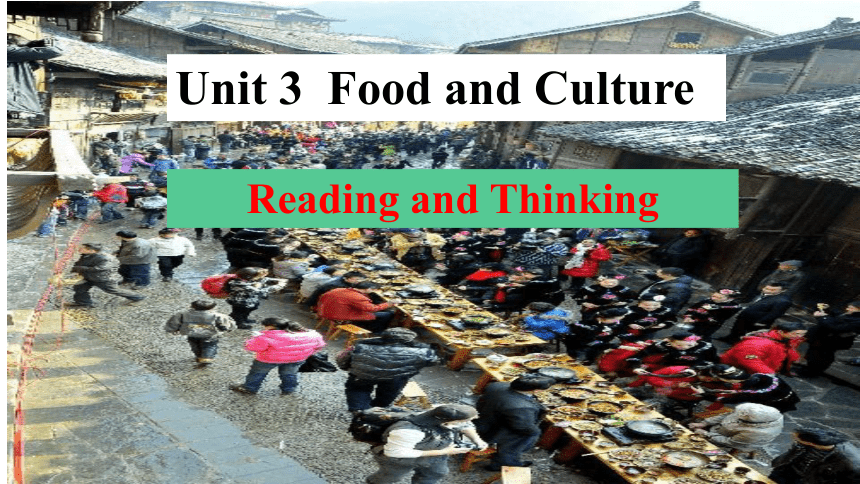 | |
| 格式 | zip | ||
| 文件大小 | 5.0MB | ||
| 资源类型 | 教案 | ||
| 版本资源 | 人教版(2019) | ||
| 科目 | 英语 | ||
| 更新时间 | 2023-01-28 08:58:23 | ||
图片预览

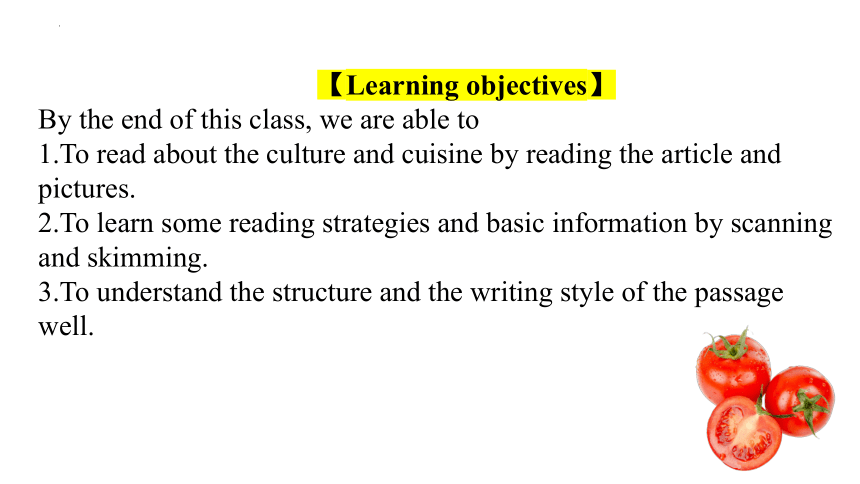
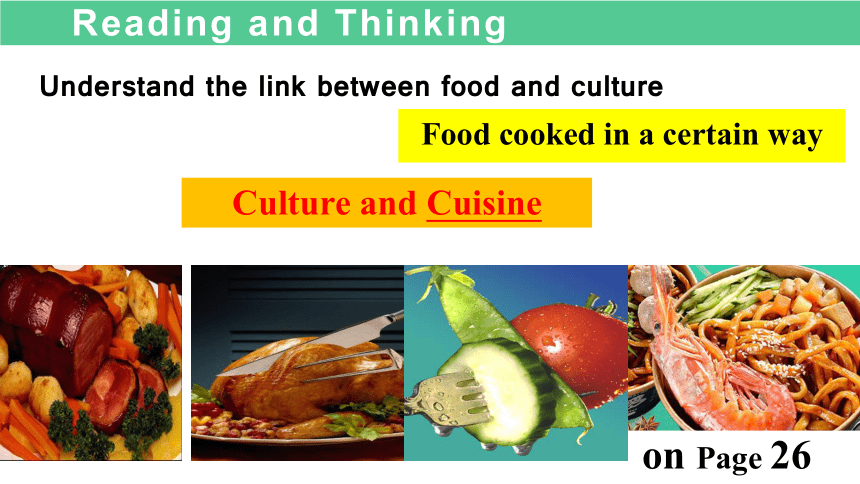
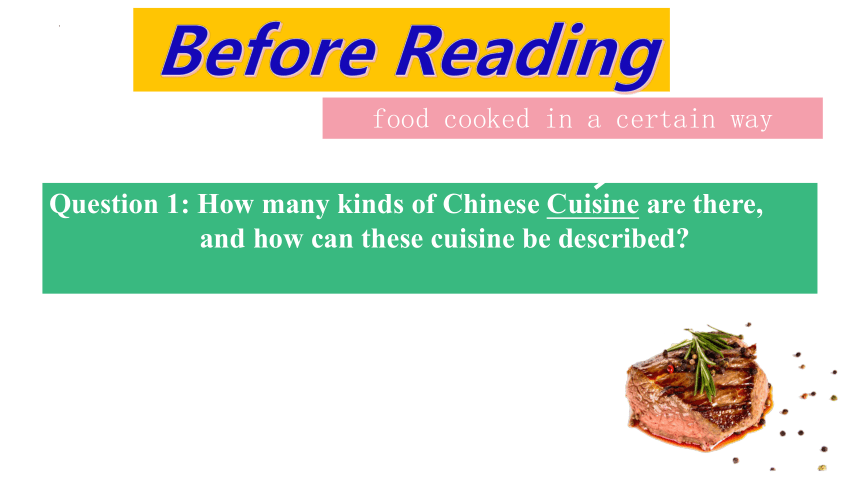
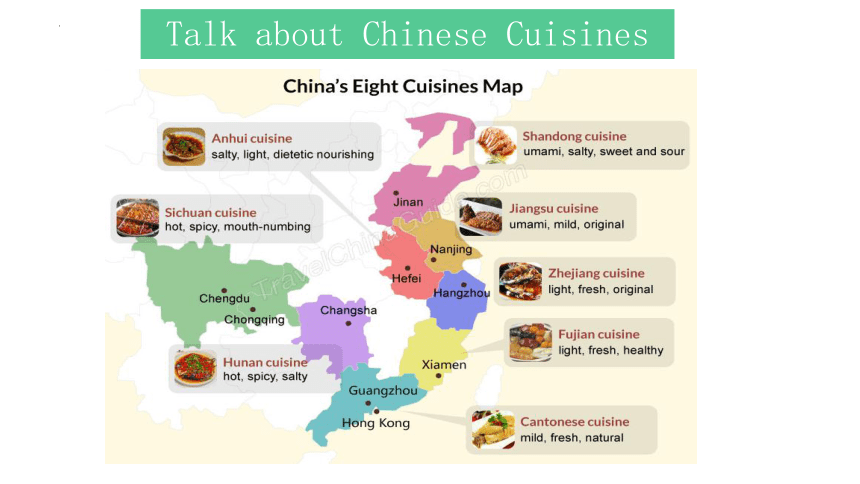
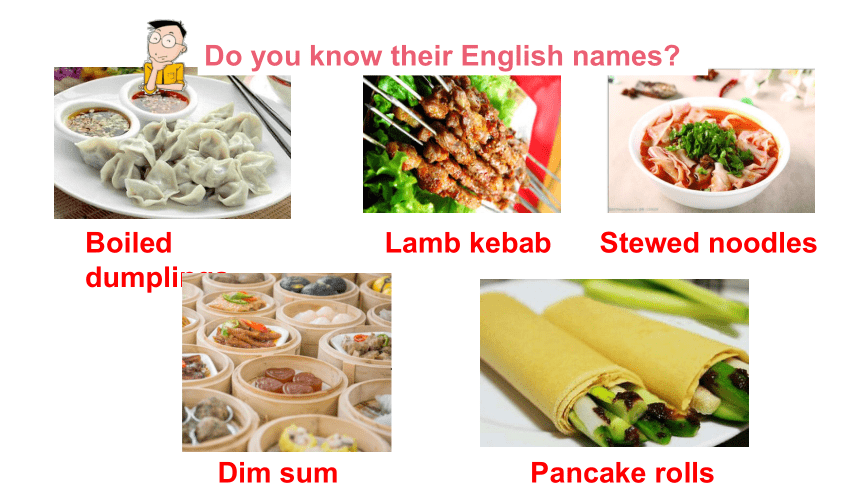
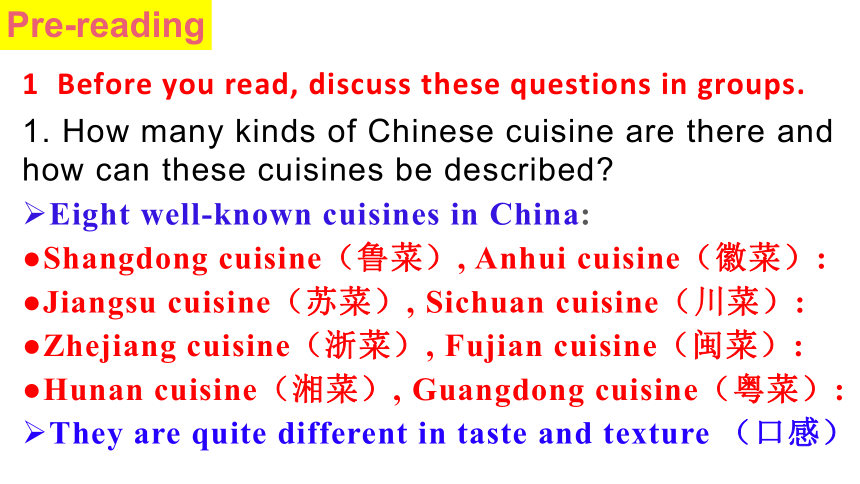
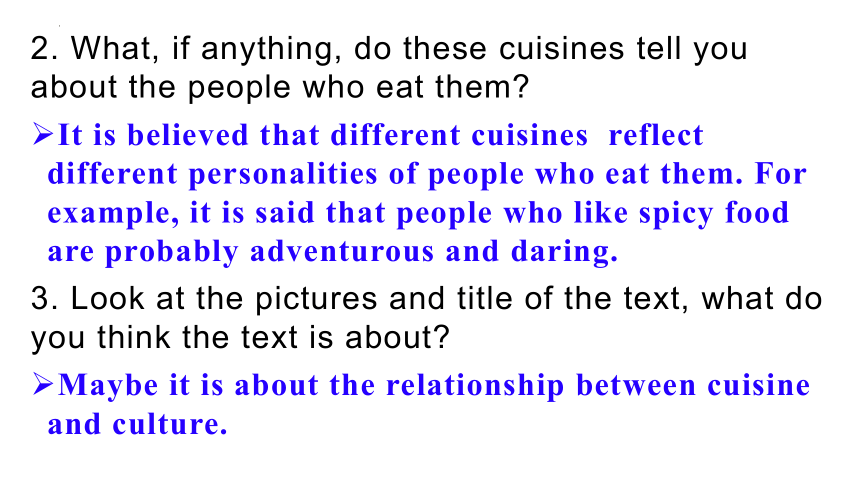
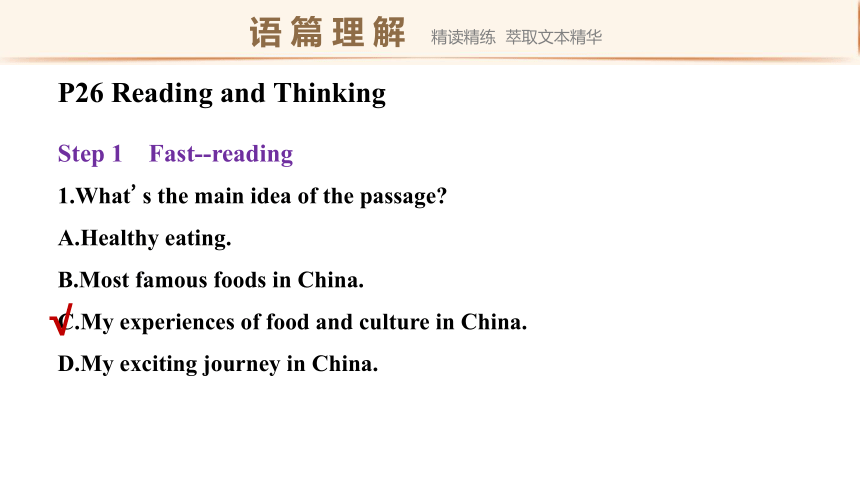
文档简介
(共28张PPT)
Unit 3 Food and Culture
Reading and Thinking
【Learning objectives】
By the end of this class, we are able to
1.To read about the culture and cuisine by reading the article and pictures.
2.To learn some reading strategies and basic information by scanning and skimming.
3.To understand the structure and the writing style of the passage well.
Reading and Thinking
on Page 26
Culture and Cuisine
Understand the link between food and culture
Food cooked in a certain way
Before Reading
Question 1: How many kinds of Chinese Cuisine are there,
and how can these cuisine be described
food cooked in a certain way
Talk about Chinese Cuisines
Boiled dumplings
Lamb kebab
Stewed noodles
Dim sum
Pancake rolls
Do you know their English names
1 Before you read, discuss these questions in groups.
1. How many kinds of Chinese cuisine are there and how can these cuisines be described
Eight well-known cuisines in China:
Shangdong cuisine(鲁菜), Anhui cuisine(徽菜):
Jiangsu cuisine(苏菜), Sichuan cuisine(川菜):
Zhejiang cuisine(浙菜), Fujian cuisine(闽菜):
Hunan cuisine(湘菜), Guangdong cuisine(粤菜):
They are quite different in taste and texture (口感)
Pre-reading
2. What, if anything, do these cuisines tell you about the people who eat them
It is believed that different cuisines reflect different personalities of people who eat them. For example, it is said that people who like spicy food are probably adventurous and daring.
3. Look at the pictures and title of the text, what do you think the text is about
Maybe it is about the relationship between cuisine and culture.
Step 1 Fast -reading
1.What's the main idea of the passage
A.Healthy eating.
B.Most famous foods in China.
C.My experiences of food and culture in China.
D.My exciting journey in China.
语 篇 理 解
精读精练 萃取文本精华
√
P26 Reading and Thinking
2.Read the passage and match the main idea of each part.
Para.1 A.Culture and cuisine go hand in hand.
Para.2 B.You are what you eat.
Paras.3-6 C.My experience of Chinese food in America.
Para.7 D.My chance to experience authentic Chinese food in different parts of China.
1. In pairs, discuss what you think this saying “You are what you eat.” means. (P26, Ex. 2)
The food we eat actually reflects our personality, character, and culture.
2. In what way does the writer show us that culture and cuisine go hand in hand
By sharing hsi different experiences with Chinese cuisine.
Scanning
1. Which is the topic paragraph
The first paragraph
2. Which is the topic sentence
The last sentence of the first paragraph.
3. What is the main idea of the text
It is about different knids of Chinese food and the culture each food represents.
Skimming
4. What type of writing is the text
Expository writing (about cause and effect)
America
Beijing
Shandong
Xinjiang
Guangdong
Henan
5. What places are mentioned where the writer experienced Chinesed food
This passage is
organized in
order of
__________.
time
6. Which of the following shows the structure of the text
A.
B.
C.
D.
How is the text organized (two clues)
prior to
later
soon
then
then
America
Beijing
Shandong
Northern
Xinjiang
South China,
Central China
place clue
time clue
Structure
Chinese food in America
Chinese food in Beijing
Chinese food in Shandong
Chinese food in Xinjiang
Chinese food in Guang Dong and Henan
(Part 3 (Para 7): Conclusion-Culture and cuisine go hand in hand.
(Part 2 (Para 2-6):Body -Experiences with Chinese cuisines
Part 1 (Para 1): Introduction-You are what you eat.
The French author Jean Anthelme Brillat-Savarin once wrote, “Tell me what you eat, and I will tell you what you are.” Put more simply, this means “You are what you eat.” Most people today relate this saying to healthy eating. However, Brillat-Savarin was referring to our personality, character and culture.
The key sentence of paragraph 1.
Paragraph 1
Q2. The first paragraph has a quote: “You are what you eat.” In pairs, discuss what you think this saying means.
Para1 You are what you eat.
Careful reading
Q1.What’s the purpose of the author using the quote in Para1
To introduce the topic
The saying means that the kind of food we eat tells something about our personality, character, and culture.
Read Para. 2-6 and discuss in group to find out the places that the author travelled, the cuisines he tasted, and the different personality/culture behind the foods.
Place Kind of Chinese food and typical dish People or culture reflected by food
America
Beijing
Shandong
Northwest China
South China
Central China
Reading & Thinking
Place Kind of Chinese food Typical dish People or culture
America
Beijing
Shandong
Chinese food changed to suit American tastes
General Tso's chicken
Americans love bold, simple flavours, and are not afraid to try new foods.
Sichan cuisine
dishes with Sichuan peppercorns
offer them good friendship.
Shandong cuisine
boiled dumplings; pancake rolls stuffed
Family is important to the people there.
3. Use the information to complete the table below.
Detailed reading
Family is important to the people there.
Place Kind of Chinese food Typical dish People or culture
Northwest China
South China
Central China
Xinjiang and Inner Mongolian cuisine
boiled or roasted meat
wandered the open range on horses ; cook food over an open fire.
Guangdong cuisine
dim sum
Henan cuisine
stewed noodles
show friendship and kindness.
At a minimum, the kinds of food local people consume tell us what they grow in their region, what kinds of lives they lead, and what they like and do not like. Could we also say, for example, that those who like bold flavours are bold themselves Or, that those who like spicy food tend to have a hot temper Maybe. Maybe not. What we can say, however, is that culture and cuisine go hand in hand, and if you do not experience one, you can never really know the other.
Para7 Culture and cuisine go hand in hand.
culture
cuisine
It can tell us their region, their life, their preference and their personalities.
To share with readers his viewpoint: Culture and cuisine go hand in hand.
Q:What can the food local people consume tell us
What’s the author’s purpose in writing this passage
Activity 5: Read to understand causes and effects.
Tips: How to identify causes and effects
because, as , so ,since ,therefore, thus,consequently, as a result ,due to...
Look for signal words , such as
2. Find them through a logical connection.
Understand cause and effect
Sometimes two ideas are related to each other by cause and effect. That is, one thing causes something else to happen. Cause-and-effect
relationships can be direct. For example,“It was raining, so I took my umbrella.”However, some cause-and-effect relationships are not direct, and some may also have more than one cause or effect.
4. Match the causes to the effects below. Then find more examples from the text.
Cause
1 The flavour preferences of Americans often
differ from those of the Chinese.
2 We had no idea how to order food.
3 These groups traditionally wandered the open
range on horses.
Effect
A The chef just began filling our table with the best
food we had ever eaten.
B Their traditional foods are what you can cook
over an open fire.
C Chinese food in America is changed to suit
American tastes.
Keys:
1. C 2. A 3. B
Match the causes to the effects below from Paragraph 2 and 3.
Cause
1. The flavour preferences of Americans often differ from those of the Chinese.
2. General Tso's Chicken is not authentic Chinese recipe.
3. We had no idea how to order food.
Effect
A. It can't tell much about China.
B. The chef just began filling our table with the best food we had ever eaten.
C. Chinese food in America is changed to suit American tastes.
Do you think “culture and cuisine go hand in hand”
Give your reasons.
Yes, because so much of a culture is based upon food and how it is eaten and served.
No, with the impact of globalization, all kinds of food are available everywhere, so food no longer reflects cultures.
In addition, in this fast-changing world, everything is changing, including cuisines.
Discussions
2. Imagine that it is true that people's personalities are closely linked to the foods they eat. What does eating the following foods tell you about a person
spicy food vegetarian food junk food seafood sweets chocolate rice noodles onion garlic bacon ham sausage cabbage mushroom bean curd
Possibly, people who like spicy food love excitement and new experiences. And people who like junk food like to enjoy life without worrying about the future.
Discussions
The French author Jean Anthelme Brillat-Savarin once wrote,“Tell me what you eat, and I will tell you what you are,” 1. means “You are what you eat.” In fact, Brillat-Savarin was actually 2. (refer) to our personality, character, and culture. In many ways, this seems to be true. Chinese cuisine is a case in point. China is a country with vast 3.______(area) and a large population. So the food is as 4. (vary) as the people. For example, people in Shandong like boiled dumplings 5._______(serve) with vinegar, because the process of making dumplings can bring the family members together. 6. (traditional), people in Xinjiang spent most of their time on horse backs, and that is 7.____ they prefer their food to 8. __(cook) over an open fire. In conclusion, through food, Chinese people everywhere show their culture as well as their friendship and 9. (kind). So what we can say is that culture and cuisine go hand 10. hand,and if you do not experience one,you can never really know the other.
which
referring
areas
varied
served
Traditionally
why
be cooked
kindness
in
Thank you ~
Unit 3 Food and Culture
Reading and Thinking
【Learning objectives】
By the end of this class, we are able to
1.To read about the culture and cuisine by reading the article and pictures.
2.To learn some reading strategies and basic information by scanning and skimming.
3.To understand the structure and the writing style of the passage well.
Reading and Thinking
on Page 26
Culture and Cuisine
Understand the link between food and culture
Food cooked in a certain way
Before Reading
Question 1: How many kinds of Chinese Cuisine are there,
and how can these cuisine be described
food cooked in a certain way
Talk about Chinese Cuisines
Boiled dumplings
Lamb kebab
Stewed noodles
Dim sum
Pancake rolls
Do you know their English names
1 Before you read, discuss these questions in groups.
1. How many kinds of Chinese cuisine are there and how can these cuisines be described
Eight well-known cuisines in China:
Shangdong cuisine(鲁菜), Anhui cuisine(徽菜):
Jiangsu cuisine(苏菜), Sichuan cuisine(川菜):
Zhejiang cuisine(浙菜), Fujian cuisine(闽菜):
Hunan cuisine(湘菜), Guangdong cuisine(粤菜):
They are quite different in taste and texture (口感)
Pre-reading
2. What, if anything, do these cuisines tell you about the people who eat them
It is believed that different cuisines reflect different personalities of people who eat them. For example, it is said that people who like spicy food are probably adventurous and daring.
3. Look at the pictures and title of the text, what do you think the text is about
Maybe it is about the relationship between cuisine and culture.
Step 1 Fast -reading
1.What's the main idea of the passage
A.Healthy eating.
B.Most famous foods in China.
C.My experiences of food and culture in China.
D.My exciting journey in China.
语 篇 理 解
精读精练 萃取文本精华
√
P26 Reading and Thinking
2.Read the passage and match the main idea of each part.
Para.1 A.Culture and cuisine go hand in hand.
Para.2 B.You are what you eat.
Paras.3-6 C.My experience of Chinese food in America.
Para.7 D.My chance to experience authentic Chinese food in different parts of China.
1. In pairs, discuss what you think this saying “You are what you eat.” means. (P26, Ex. 2)
The food we eat actually reflects our personality, character, and culture.
2. In what way does the writer show us that culture and cuisine go hand in hand
By sharing hsi different experiences with Chinese cuisine.
Scanning
1. Which is the topic paragraph
The first paragraph
2. Which is the topic sentence
The last sentence of the first paragraph.
3. What is the main idea of the text
It is about different knids of Chinese food and the culture each food represents.
Skimming
4. What type of writing is the text
Expository writing (about cause and effect)
America
Beijing
Shandong
Xinjiang
Guangdong
Henan
5. What places are mentioned where the writer experienced Chinesed food
This passage is
organized in
order of
__________.
time
6. Which of the following shows the structure of the text
A.
B.
C.
D.
How is the text organized (two clues)
prior to
later
soon
then
then
America
Beijing
Shandong
Northern
Xinjiang
South China,
Central China
place clue
time clue
Structure
Chinese food in America
Chinese food in Beijing
Chinese food in Shandong
Chinese food in Xinjiang
Chinese food in Guang Dong and Henan
(Part 3 (Para 7): Conclusion-Culture and cuisine go hand in hand.
(Part 2 (Para 2-6):Body -Experiences with Chinese cuisines
Part 1 (Para 1): Introduction-You are what you eat.
The French author Jean Anthelme Brillat-Savarin once wrote, “Tell me what you eat, and I will tell you what you are.” Put more simply, this means “You are what you eat.” Most people today relate this saying to healthy eating. However, Brillat-Savarin was referring to our personality, character and culture.
The key sentence of paragraph 1.
Paragraph 1
Q2. The first paragraph has a quote: “You are what you eat.” In pairs, discuss what you think this saying means.
Para1 You are what you eat.
Careful reading
Q1.What’s the purpose of the author using the quote in Para1
To introduce the topic
The saying means that the kind of food we eat tells something about our personality, character, and culture.
Read Para. 2-6 and discuss in group to find out the places that the author travelled, the cuisines he tasted, and the different personality/culture behind the foods.
Place Kind of Chinese food and typical dish People or culture reflected by food
America
Beijing
Shandong
Northwest China
South China
Central China
Reading & Thinking
Place Kind of Chinese food Typical dish People or culture
America
Beijing
Shandong
Chinese food changed to suit American tastes
General Tso's chicken
Americans love bold, simple flavours, and are not afraid to try new foods.
Sichan cuisine
dishes with Sichuan peppercorns
offer them good friendship.
Shandong cuisine
boiled dumplings; pancake rolls stuffed
Family is important to the people there.
3. Use the information to complete the table below.
Detailed reading
Family is important to the people there.
Place Kind of Chinese food Typical dish People or culture
Northwest China
South China
Central China
Xinjiang and Inner Mongolian cuisine
boiled or roasted meat
wandered the open range on horses ; cook food over an open fire.
Guangdong cuisine
dim sum
Henan cuisine
stewed noodles
show friendship and kindness.
At a minimum, the kinds of food local people consume tell us what they grow in their region, what kinds of lives they lead, and what they like and do not like. Could we also say, for example, that those who like bold flavours are bold themselves Or, that those who like spicy food tend to have a hot temper Maybe. Maybe not. What we can say, however, is that culture and cuisine go hand in hand, and if you do not experience one, you can never really know the other.
Para7 Culture and cuisine go hand in hand.
culture
cuisine
It can tell us their region, their life, their preference and their personalities.
To share with readers his viewpoint: Culture and cuisine go hand in hand.
Q:What can the food local people consume tell us
What’s the author’s purpose in writing this passage
Activity 5: Read to understand causes and effects.
Tips: How to identify causes and effects
because, as , so ,since ,therefore, thus,consequently, as a result ,due to...
Look for signal words , such as
2. Find them through a logical connection.
Understand cause and effect
Sometimes two ideas are related to each other by cause and effect. That is, one thing causes something else to happen. Cause-and-effect
relationships can be direct. For example,“It was raining, so I took my umbrella.”However, some cause-and-effect relationships are not direct, and some may also have more than one cause or effect.
4. Match the causes to the effects below. Then find more examples from the text.
Cause
1 The flavour preferences of Americans often
differ from those of the Chinese.
2 We had no idea how to order food.
3 These groups traditionally wandered the open
range on horses.
Effect
A The chef just began filling our table with the best
food we had ever eaten.
B Their traditional foods are what you can cook
over an open fire.
C Chinese food in America is changed to suit
American tastes.
Keys:
1. C 2. A 3. B
Match the causes to the effects below from Paragraph 2 and 3.
Cause
1. The flavour preferences of Americans often differ from those of the Chinese.
2. General Tso's Chicken is not authentic Chinese recipe.
3. We had no idea how to order food.
Effect
A. It can't tell much about China.
B. The chef just began filling our table with the best food we had ever eaten.
C. Chinese food in America is changed to suit American tastes.
Do you think “culture and cuisine go hand in hand”
Give your reasons.
Yes, because so much of a culture is based upon food and how it is eaten and served.
No, with the impact of globalization, all kinds of food are available everywhere, so food no longer reflects cultures.
In addition, in this fast-changing world, everything is changing, including cuisines.
Discussions
2. Imagine that it is true that people's personalities are closely linked to the foods they eat. What does eating the following foods tell you about a person
spicy food vegetarian food junk food seafood sweets chocolate rice noodles onion garlic bacon ham sausage cabbage mushroom bean curd
Possibly, people who like spicy food love excitement and new experiences. And people who like junk food like to enjoy life without worrying about the future.
Discussions
The French author Jean Anthelme Brillat-Savarin once wrote,“Tell me what you eat, and I will tell you what you are,” 1. means “You are what you eat.” In fact, Brillat-Savarin was actually 2. (refer) to our personality, character, and culture. In many ways, this seems to be true. Chinese cuisine is a case in point. China is a country with vast 3.______(area) and a large population. So the food is as 4. (vary) as the people. For example, people in Shandong like boiled dumplings 5._______(serve) with vinegar, because the process of making dumplings can bring the family members together. 6. (traditional), people in Xinjiang spent most of their time on horse backs, and that is 7.____ they prefer their food to 8. __(cook) over an open fire. In conclusion, through food, Chinese people everywhere show their culture as well as their friendship and 9. (kind). So what we can say is that culture and cuisine go hand 10. hand,and if you do not experience one,you can never really know the other.
which
referring
areas
varied
served
Traditionally
why
be cooked
kindness
in
Thank you ~
